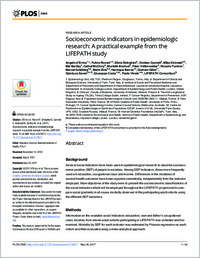Socioeconomic indicators in epidemiologic research: A practical example from the LIFEPATH study.
- d'Errico A Epidemiology Unit, ASL TO3, Piedmont Region, Grugliasco, Torino, Italy.
- Ricceri F Epidemiology Unit, ASL TO3, Piedmont Region, Grugliasco, Torino, Italy.
- Stringhini S Institute of Social and Preventive Medicine and Department of Psychiatry and Department of Internal Medicine, Lausanne University Hospital, Lausanne, Switzerland.
- Carmeli C Institute of Social and Preventive Medicine and Department of Psychiatry and Department of Internal Medicine, Lausanne University Hospital, Lausanne, Switzerland.
- Kivimaki M University College London, Department of Epidemiology and Public Health, London, United Kingdom.
- Bartley M University College London, Department of Epidemiology and Public Health, London, United Kingdom.
- McCrory C The Irish Longitudinal Study on Ageing (TILDA), Trinity College Dublin, Ireland.
- Bochud M Institute of Social and Preventive Medicine and Department of Psychiatry and Department of Internal Medicine, Lausanne University Hospital, Lausanne, Switzerland.
- Vollenweider P Institute of Social and Preventive Medicine and Department of Psychiatry and Department of Internal Medicine, Lausanne University Hospital, Lausanne, Switzerland.
- Tumino R Cancer Registry, Department of Prevention, ASP, Ragusa, Italy.
- Goldberg M Population-based Epidemiological Cohorts Unit, INSERM UMS 11, Villejuif, France.
- Zins M Population-based Epidemiological Cohorts Unit, INSERM UMS 11, Villejuif, France.
- Barros H EPIUnit- Institute of Public Health, University of Porto, Porto, Portugal.
- Giles G Cancer Epidemiology Centre, Cancer Council Victoria, Melbourne, Australia.
- Severi G Centre de Recherche en Épidémiologie et Santé des Populations (CESP, Inserm U1018), Université Paris-Saclay, UPS, USQ, Gustave Roussy, Villejuif, France.
- Costa G Epidemiology Unit, ASL TO3, Piedmont Region, Grugliasco, Torino, Italy.
- Vineis P MRC-PHE Centre for Environment and Health, School of Public Health, Department of Epidemiology and Biostatistics, Imperial College London, London, United Kingdom.
- 2017-05-31
Published in:
- PloS one. - 2017
English
BACKGROUND
Several social indicators have been used in epidemiological research to describe socioeconomic position (SEP) of people in societies. Among SEP indicators, those more frequently used are education, occupational class and income. Differences in the incidence of several health outcomes have been reported consistently, independently from the indicator employed. Main objectives of the study were to present the socioeconomic classifications of the social indicators which will be employed throughout the LIFEPATH project and to compare social gradients in all-cause mortality observed in the participating adult cohorts using the different SEP indicators.
METHODS
Information on the available social indicators (education, own and father's occupational class, income) from eleven adult cohorts participating in LIFEPATH was collected and harmonized. Mortality by SEP for each indicator was estimated by Poisson regression on each cohort and then evaluated using a meta-analytical approach.
RESULTS
In the meta-analysis, among men mortality was significantly inversely associated with both occupational class and education, but not with father's occupational class; among women, the increase in mortality in lower social strata was smaller than among men and, except for a slight increase in the lowest education category, no significant differences were found.
CONCLUSIONS
Among men, the proposed three-level classifications of occupational class and education were found to predict differences in mortality which is consistent with previous research. Results on women suggest that classifying them through their sole SEP, without considering that of their partners, may imply a misclassification of their social position leading to attenuation of mortality differences.
Several social indicators have been used in epidemiological research to describe socioeconomic position (SEP) of people in societies. Among SEP indicators, those more frequently used are education, occupational class and income. Differences in the incidence of several health outcomes have been reported consistently, independently from the indicator employed. Main objectives of the study were to present the socioeconomic classifications of the social indicators which will be employed throughout the LIFEPATH project and to compare social gradients in all-cause mortality observed in the participating adult cohorts using the different SEP indicators.
METHODS
Information on the available social indicators (education, own and father's occupational class, income) from eleven adult cohorts participating in LIFEPATH was collected and harmonized. Mortality by SEP for each indicator was estimated by Poisson regression on each cohort and then evaluated using a meta-analytical approach.
RESULTS
In the meta-analysis, among men mortality was significantly inversely associated with both occupational class and education, but not with father's occupational class; among women, the increase in mortality in lower social strata was smaller than among men and, except for a slight increase in the lowest education category, no significant differences were found.
CONCLUSIONS
Among men, the proposed three-level classifications of occupational class and education were found to predict differences in mortality which is consistent with previous research. Results on women suggest that classifying them through their sole SEP, without considering that of their partners, may imply a misclassification of their social position leading to attenuation of mortality differences.
- Language
-
- English
- Open access status
- gold
- Identifiers
-
- DOI 10.1371/journal.pone.0178071
- PMID 28557991
- Persistent URL
- https://sonar.ch/global/documents/25197
Statistics
Document views: 16
File downloads:
- fulltext.pdf: 0
